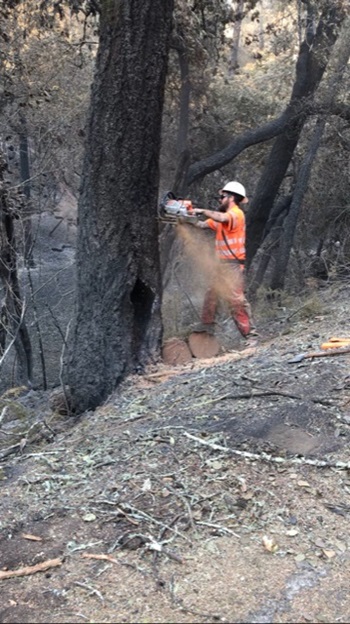District 1 Acting Tree Crew Supervisor Michael Quinliven cuts down a hazardous tree during the disastrous October northern California fires. Photo by District 1 
District 1 Acting Tree Crew Supervisor
Editor’s Note: Caltrans staff across the department pitched in during the disastrous October California fires that burned more than 245,000 acres in 13 counties. Many Californians lost their homes, nearly 100,000 people were evacuated, and 8,920 structures were lost, and 43 people died.
Caltrans employees worked long shifts at emergency operation centers, assisting in evacuations, clearing dead trees, rebuilding damaged guardrail, pavement and melted culverts – and more. Here is the account of a Caltrans Maintenance Tree Crew Supervisor.
My crew, Ukiah District 1 Tree Crew South, and I started working the Redwood Valley Fire Complex in Mendocino County on Oct. 9. The fire had started Oct. 8, and was ravaging the forest north of Highway 20, west of the Mendocino National Forest.
Our first day, tree crew members worked 12 to 17 hours, helping with traffic control, taking inventory of burnt trees, and assessing the damage to our state right of way trees. After we finished the tree assessments, we initiated the “tree felling” process of cutting down trees. Some of the most dangerous trees were still smoldering. While the highway was shut down for the safety of the public, we eliminated the dangerous trees. We worked on the redwood complex fire for two days. The second day we monitored the trees that were in the smoldering stage and still flaring up. We worked with Cal Fire’s incident response to eliminate problem trees. We also cleaned up the trees that had fallen in our absence overnight.
On Oct. 13, we were called to the Sonoma and Napa county fire, so we loaded our trucks and headed to Geyserville from Ukiah to meet the District 4 maintenance crew. First, we assessed the burnt trees on Highway 128 right of way toward Calistoga. Then we started the felling process. We cut for approximately two miles on both sides of the highway, from the start of the burn to the end of the burn on Caltrans property. Mind you the tree felling process takes approximately 5 to 35 minutes per tree, depending on the location and condition. And sometimes it takes even longer. We use large, heavy chainsaws, and we were working 12-hour days in warm to very hot weather and heavy smoke.
When assessing a tree’s location and condition, we consider many things. We look at the surroundings, where the tree may fall and the best place for it to fall. This means sometimes you have to use multiple rigging (rope tie) points, using pulleys and large ropes to fell the tree in a safely controlled direction. It is important to check the immediate area for hazards, such as phone lines, power lines, houses, fences and people on the ground. We use a lot of radio communication throughout the work zone.
It is a lot to think about when you are trying to move forward on a project like that, but it’s a necessity for the safety of all involved. District 4 Calistoga Maintenance, Geyserville Maintenance, Santa Rosa Tree Crew, as well as both District 1 Tree Crews north and south, were all working with us. We had multiple loaders, 10-yard dump trucks, four-yard dump trucks, brush chippers and aerial lifts and other equipment to help us do our job safely.
Some of us worked 12 to 17 hours a day for 10 to 13 days straight, away from our loved ones. We were beat, tired and covered from head to toe in coal and dirt. At the end of one of our long 12-hour days, when I sat down for a second to rest, I soon realized how sore I was. My feet hurt. I had blisters on the bottom of them. My legs didn’t want to move. My back was sore, and I asked myself, “Why do we do this?”
As I pulled off my wedding ring to get cleaned up, it hit me. The only clean spot on my charcoal-stained hands was under my wedding ring. I immediately thought of my family, my beautiful wife and daughter that I had been missing so much because I hadn’t seen them in days upon days. We work to provide and take care of our loved ones, but that was not the only thing I thought about.
I thought about all the folks who lost their houses and everything they owned and how they have nothing to go home to. I thought about all the Caltrans workers who worked countless hours, as I did, and how they must feel – how their bodies and minds have to be tired and hurting, and they too must be missing their families dearly.
After my moment of realization, I told myself that’s why we do this. This isn’t just for a paycheck. We are helping our fellow brothers and sisters in times of devastation, helping make the roads safe again so the folks that have been evacuated can return home on a safe highway and reunite with their loved ones. The next day, we woke up and went back to work until we were done and could go home. I didn’t hear anyone complain the whole time.
Seeing the two districts come together as one and work that great together was an unreal experience. It was a family. I felt like I had known these people for years. It was an extension of my family. It was a beautiful sight to see and experience. Caltrans is a family, and I felt that during this time when everyone came together.

